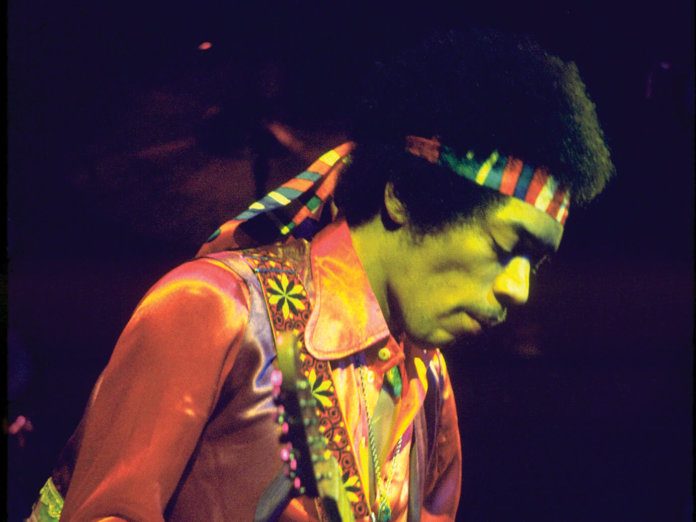Given the importance of live shows to the Jimi Hendrix story, it seems fitting that he should have spent the last night of the 1960s on stage blowing a hole through the Fillmore East, before returning the next day to finish the job. Hendrix’s entire two-day, four-show stint over New Year at the Fillmore with the Band Of Gypsys was recorded by Wally Heider and now, for the first time, all four shows are in one place. Co-produced by Eddie Kramer, the set comes on CD and vinyl with unseen photos and liner notes by Nelson George and Billy Cox.
Six tracks from Fillmore East first appeared on Band Of Gypsys – the last album released in Hendrix’s lifetime – while three more appeared on ’80s follow-up Band Of Gypsys 2. The 1999 Live At The Fillmore East had 16 more in haphazard order. There were three on the West Coast Seattle Boy anthology, while New Year’s Eve’s entire first set came out in 2016 as Machine Gun: The Fillmore East First Show. Despite this piecemeal history, this box debuts eight previously unreleased tracks. Another three are appearing on CD/LP for the first time and several others can be heard for the first time in their unedited form. Most importantly, the box gives us four distinct but related sets to enjoy pretty much in their entirety, showing the way bassist Billy Cox and drummer Buddy Miles were finessing songs live as Jimi improvised a post-Experience direction. You can hear why the Band Of Gypsys were created, but also why they split within months.
The concerts were arranged because Hendrix needed to satisfy an old contract and didn’t want to spend any studio time on it. Cox and Miles were recruited to form an all-black power trio, a little funkier and freer than the Experience, and they started rehearsing in New York in December 1969. Cox, an old friend of Hendrix’s since their time together in the Army, was a supportive bassist, but Miles, late of Electric Flag, was more of a challenge, largely due to his over-enthusiastic supporting vocals. When he suddenly starts scatting midway through an emotional early version of “Machine Gun”, you can almost sense Hendrix’s surprise. Part of the fun of Songs For Groovy Children is hearing Hendrix adjust in real time to changing circumstances. “Machine Gun” appears in four subtly different guises, with the spectral 13-minute second take dedicated to “everybody who has died or is going to die… happy new year.” The third version was used on Band Of Gypsys, but any could have made the cut.
The four sets are sufficiently different to reward a listener prepared to sit through all of them, with Hendrix adapting and refining his solos once the body of a song has been established. The fascinating first, which took place on New Year’s Eve 1969, consisted entirely of unreleased material, and the band are openly feeling their way through new songs like “Earth Blues”, “Power Of Soul” and “Burning Desire” as well as others written but not recorded with the Experience like “Lover Man”, “Izabella” and “Machine Gun”. It’s laidback but there’s a clear desire to nail things quickly.
Before “Ezy Rider”, Hendrix grins “Let’s make the words up as we go along because we got something like 20 verses of it.” There’s a bluesy feel with Band Of Gypsys and one early highlight is a sweaty “Hear My Train A Coming”, one of the best songs from both New Year’s Eve shows, while “Earth Blues” increasingly grows in its various forms over the two nights. The second set took place just after midnight and is more raucous, starting with a cheeky “Auld Lang Syne” and including a shrieking “Foxey Lady” and wild 17-minute “Stone Free” that references Tchaikovsky and Cream while finding time for a drum solo. A handful of tracks have been cut from this set for unspecified reasons, possibly as the band didn’t complete them or they weren’t caught on tape.
Band Of Gypsys drew entirely from the new material performed at the two New Year’s Day shows. The third set (the first on New Year’s Day 1970) contains the definitive “Machine Gun”, slinkier “Burning Desire” and a fuller, more considered take on “Earth Blues”, while the fourth set has a poppy “Message To Love” and “Power Of Soul”, featuring here with three restored minutes of manic freestyling. The focus on new songs meant it overlooked Hendrix’s unfussy fourth-set encore of Experience hits – “Voodoo Child”, “Wild Thing”, “Hey Joe” and “Purple Haze”, and the latter two are released here for the first time in punchy but not massively transformed form. Also previously unreleased from the fourth set is a good take of “Lover Man” and a surprising cover of “Steal Away”, with Miles on lead vocals.
Many of the tracks that appeared on the original Band Of Gypsys were edited by Hendrix and Kramer, for length but also to eradicate Miles’s extraneous vocals. These now appear in their original form. As well as backing Hendrix, Miles takes lead on several tracks – the box has four versions of his pleasing pop-soul number “Changes”/“Them Changes”, as well as three covers of “Stop” and a full version of the fourth set’s “We Gotta Live Together”, including its segue from “Voodoo Child”. His fine but bland singing style highlights Hendrix’s own underrated voice, which retains its power over what must have been a punishing two nights and has a texture and timbre as unique as his guitar playing. The latter, of course, is out of this world.



